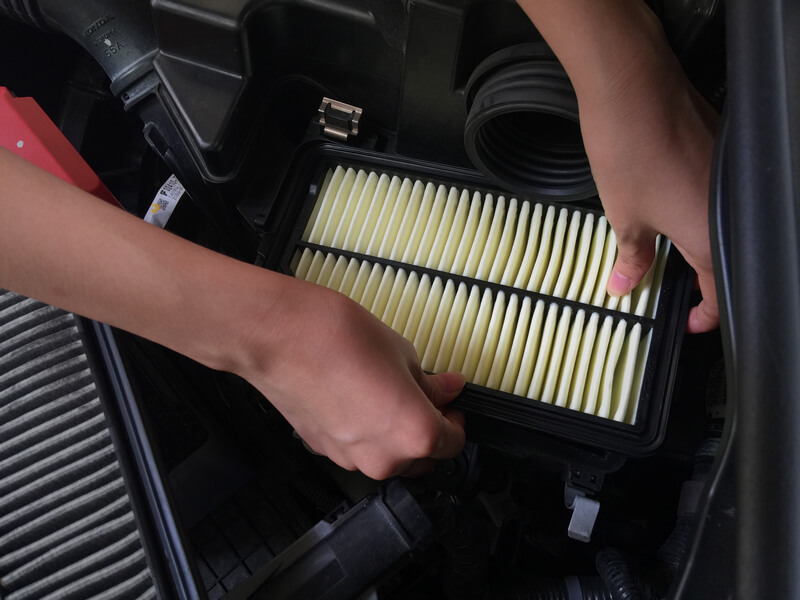In the early 1980s, automobile manufacturers began to ditch the round, paper air filter elements typically used on carbureted engines in favor of flat filters funneling air to fuel-injected engines. Often, factory air boxes reduce power. The air inlet passages provide the engine with enough air for stock output but are not performance-oriented.

*Note: Please check local laws before modifying your vehicle. Vehicle modifications may void manufacturers’ warranties and may be illegal for use on roads and highways, depending on where you live. Many modifications can cause failed smog tests.
Aftermarket Solution for Inefficient Stock Air Filters
A simple solution for many choked-up fuel-injected vehicles is to replace the factory air filter and box with an aftermarket piece called a cold air intake.

A rigid pipe routes air to the air inlet at the manifold from an open area near the radiator air inlet. Most cold air inlet systems feature an exposed conical filter. Air filters can be bare paper, cellular foam, or oil-bathed and are intended to draw more air from cooler places than the factory air filter.
How Cold Air Intakes Work
In theory, a cold air intake can add horsepower and improve gas mileage. The added performance is a result of a colder, denser charge of air. The free-flowing inlet pipe allows less turbulent air that is moving faster and contains more oxygen than stock systems. Well-built systems can increase both horsepower and torque and can improve fuel mileage as well. A cold air intake usually makes an engine louder because the larger volume of air is less restricted.
Things to Be Aware of Before Installing a Cold Air Intake
With most aftermarket car parts, you get what you pay for, and cold air intakes are the same. Dozens of online sellers offer really nice-looking kits for cheap, and they claim some eye-popping power numbers, too. The reality is that most of these types of kits are inferior to the stock system and may even cause idle issues, stalling, surging, and check engine light illumination.
Cold air intakes can increase the risk of water flooding an engine. High-performance filters can allow water to be sucked into the engine. This can result in a condition called hydro-locking. Hydro-locking is caused when water enters a cylinder. Unlike air, water does not compress. Hydro-locking can literally cause the engine to stop in mid-rotation, destroying itself in the process.
How To Spot A Good Cold Air Intake System
Several highly popular companies sell aftermarket cold air intake systems that are better than stock filters, but they are not cheap. A good first step is to research filters popular with owners. Try to find enthusiasts online for advice on the particular make and model of the vehicle.
Look for intake pipes that are as straight as possible. Some vehicles have issues with cold air intake pipes that have a 90-degree angle. These types of intake kits can make the air “roll” and confuse the Mass Air Flow Sensor.
A cold air intake is practically useless without a really good air filter. Cheap intake systems often include a paper filter element that is more restrictive than stock.
Air Filters for Cold Air Intake
Many companies sell performance air filters with claims of massive horsepower and torque gains. Most of this is marketing. A good system with a high-quality air filter will give most cars a 1-8 horsepower gain and about 1.5 miles per gallon extra under normal driving.
An inferior air filter makes the whole thing worthless. Spend the money on a good filter. Oil-bathed filters like those sold by K&N and AIRAID are exceptional in dusty, dry places. In severely filthy places, open-cell foam can help prevent clogging an oil-bathed filter.
The Easiest Upgrade
The average car owner can install a cold air intake on almost any vehicle in a matter of minutes using common hand tools. Removing the stock airbox is the most difficult part. Consult a repair manual that includes information on how to properly remove the air box without damaging it should you need to reuse it at a later time. Do not throw your stock system away.
Generally, cold air intakes will attach to the air inlet of the mass airflow sensor with a band-type hose clamp. A bracket typically fastens the other end to a solid part of the vehicle and directs the inlet toward a source of fresh air. The filter attaches with a band-type clamp to the inlet. Installation is complete.
Troubleshooting Tips
Start the car and let it idle for a few minutes to ensure no check engine light comes on. If one does get a dash light, the airflow might be too high, or the air/fuel mixture may have exceeded specifications.
A good vehicle repair manual will give instructions to do-it-yourself mechanics for correcting issues caused by high-flow filters that confuse vehicle computers. This situation is pretty rare when using one of the higher-end products because the companies have extensively tested the setups for proper performance. Generally, a good system will come from a company that has a helpful customer service line.
The engine is likely to produce more noise with a cold air intake system. A good cold air intake will make the engine sound more powerful. If for nothing else, a cold air intake can be worth the sound. If the noise is too much, consider using a high-quality sound barrier under the hood.
It is important to pay close attention to the emissions laws in your area. Many localities will not test or will automatically fail vehicles with aftermarket cold air intake systems. I hope you saved your stock equipment. Some states ban most aftermarket parts that don’t carry a certification.
The First Performance Step Any Driver Should Make
High-end systems can cost several hundred dollars U.S. It is possible to spend even more than that, too. A full custom cold air intake may run into the thousands. Performance air filters alone can cost $150 or more. Drivers must use a special oil to periodically clean oil-bathed air filters. Oil-bathed filters last longer than paper filters because drivers can clean and reuse oil-bathed filters indefinitely.

Buy the best quality system you can afford. A good cold air intake is the first step to really opening the performance possibilities of an engine. No modifications to the exhaust, timing, or other engine control matter unless the engine can get more air.
Frequently Asked Questions (FAQs)
What do cold air intakes do?
The primary purpose of a cold air intake is to deliver a colder air charge to the engine than a factory intake system does. Colder air is denser in oxygen and, as such, literally equals higher power output, lower fuel consumption, and a healthier engine. They are also less restrictive, further increasing horsepower.
However, not all cold air intakes are the same. For example, suppose you take your standard airbox out and just put a cone air filter instead. In that case, the filter will suck the hot air from the engine bay and actually decrease horsepower. The same thing happens with a poorly designed cold air intake, creating more restrictions than stock and basically defeating the whole purpose.
A proper system will replace the air box with a heat shield that fits perfectly into your car, sealing against the hood. Other designs might also relocate the air filter entirely, placing it low in the front bumper. The point is to take the intake away from the engine or physically separate the intake from the engine bay. They also include metal pipes that dissipate heat better than standard plastic or rubber.
Does a cold air intake replace the air filter?
Yes — a cold air intake replaces your factory air filter and includes a new, redesigned high-flow filter. Indeed, the filter you get with a cold air intake is usually an open cone design that deletes the factory air box, but other styles are also available. Also, more expensive high-flow air filters will often come with their own housing and a heat shield, bringing colder air to the engine. Getting a high-flow panel type that fits into your factory air box is also an option but won’t bring the same level of improvement as a full-on cold air intake.
Do cold air intakes really work?
Yes — well-designed cold air intakes that come from proven brands actually do work. Colder air is denser and contains more oxygen; more oxygen allows for more fuel to be injected, ultimately increasing power output. The physics behind cold air intakes is undeniable.
That said, designing an efficient cold air intake isn’t so straightforward. Cheaper brands or the no-name stuff you get online might result in horsepower loss instead. So, when buying one, it’s crucial to spend a little more money and get one from a well-known engineering company. A complete cold air intake kit includes smoother pipes that reduce air drag and a less restrictive air filter, further assisting in power gains. Depending on your car, you can roughly get an increase of anywhere from 5 to 20 horsepower, but only if you go for a model designed and engineered to do so. Bigger chromed pipes and a filter with flames on the side don’t necessarily mean more power.
Why is a cold air intake better?
A cold air intake is better because it brings colder air into the engine, allowing more fuel to be sent in and increasing power — hence why many turbocharged vehicles come with an intercooler as standard. In normal driving conditions, a high-quality cold air intake is superior to the factory one in almost every way. Plus, even the good ones are usually inexpensive, considering the potential performance gains.
However, the manufacturer has set up your vehicle to run optimally in all conditions, so at temperatures between -20°F and 120°F, at sea level, and at elevations of 13,000ft. As a result, a cold air intake might throw the car’s ECU off and, for example, make it harder to start on freezing mornings (that can be solved by remapping the ECU, but that’s beyond the scope of this article). If usability is a bigger priority to you than performance, it’s better to stick with the factory intake.
Does a cold air intake increase horsepower?
Yes — but it depends on which. A well-designed cold air intake increases power anywhere between 5hp and 20hp or more for really advanced models. However, power gains depend primarily on your car model and the intake manufacturer. So, for example, a stock 2.0l naturally aspirated car will usually get a small 5hp increase. A 3.0l turbocharged engine would get around 15hp more, and an S550 Mustang with a Coyote V8 can sometimes gain over 20hp.
Still, this is really a very, very “ballpark” estimate. The reason why the Mustang receives such a bigger bump in power doesn’t necessarily down to the engine, though. It has more to do with the Mustang being a popular car to modify and engineering companies competing to make the best parts for them.
Moreover, it’s also a question of how hard you went with your tune. An OEM naturally-aspirated engine now turbocharged and consequently being almost choked out by the stock airbox would benefit a lot more from a bigger intake than a stock one, for instance. Let’s just say that you might see even higher power gains when combined with other mods like an exhaust system, more aggressive cams, or an ECU remap.
Is a cold air intake worth it?
A quality cold air intake is definitely worth the money. Increasing power output in a vehicle is never a cheap task, and the dollar-per-horsepower ratio is on the cold air intake’s side. If we exclude an ECU tune on turbocharged cars, they are one of the best mods for your bucks.
When compared to performance exhausts, for example, sure, a full exhaust system, including a high-flow cat and a race manifold, can give you 50% more power than a cold air intake but will also cost three times as much. That means if a CAI increases the power by 20hp, a performance exhaust will give you 30hp. However, their price and gains, as always, depending on the car model. Cold air intakes can cost thousands of dollars for some cars and bring the same gains you would see on a Honda Civic with a 300$ intake.
Furthermore, turbocharged vehicles will see a higher increase in horsepower, and the whole system won’t necessarily be any more expensive than one for a N/A engine. Ultimately, it comes down to personal preference whether or not they are worth the money. Still, if you are after performance, you will hardly find a more straightforward and cheaper solution.











Nice blog!!!
I have gained more information on your blog. I am also doing business-related Automotive. Thanks for sharing this.
@Dean, Thank you for the feedback!